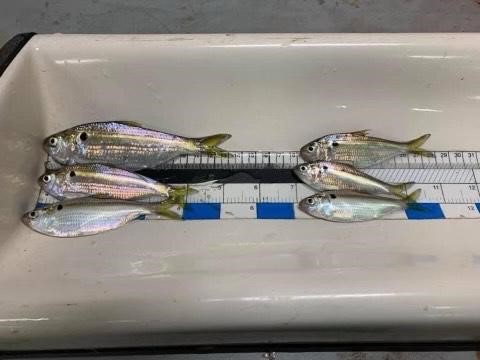
There is a small window of time to harvest Threadfin shad in order to minimize harvest mortality. Water temperatures cannot be too warm or too cold. We have found that it is best to harvest Threadfin shad when water temperatures are 65 to 70 F. Once the water temperatures are in this range the ponds are drawn down and harvested. In north there could be cold snaps that really drop pond temperatures. Therefore, the hatchery has been busy the last few weeks trying to complete the harvest before the cold weather set in. Threadfin shad are not very cold tolerant and begin to die off when water temperatures drop below 42 degrees Fahrenheit. Unlike most lakes, the hatchery ponds are not deep enough to provide a thermal refuge for the shad to seek out warmer water to survive the winter.
Threadfin shad are important food sources for sportfish like black bass. The AGFC culture facilities produce these shad in order to help supplement or boost populations in certain lakes that may be lacking enough forage to keep sport fish populations fat and healthy. For instance, one of the lakes that was stocked (Lake Fort Smith with 52,600 yearlings), has Largemouth bass populations experiencing Relative Weight (Wr) condition assessments in the mid-80s. Relative weight is a measure of how plump or fat a fish is. These should be in the 95 to 100 range which indicates a lack of sufficient forage. AGFC hopes to improve the health of fish populations such as Largemouth bass through these stockings.
The Charlie Craig State Fish Hatchery (CCSFH) produced a bumper crop of Threadfin shad this year. The hatchery started with 2,740 adult fish (67lbs.) in 5 acres of ponds and produced 606,100 shad yearlings (2,200 lbs.). CCSFH stocked 594,900 of those shad into lakes around the state. The other 11,200 will be held indoors through the winter to be utilized as broodstock next production season.
CCSFH stocked the following locations in the Northwest Region of the state:
Lake Elmdale - 12,000
Lake Fort Smith – 52,600
Sugarloaf Lake – 105,000
